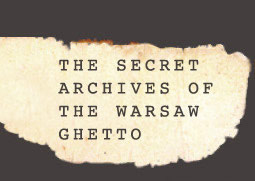The Warsaw Ghetto
Emmanuel Ringelblum, historian
The Oyneg Shabbes collective
Alerting the world
The Preservation of the Archives
Rediscovery
The Warsaw Ghetto
After the Nazi invasion in September 1939, Poland was dismembered. The Western and Northern regions were annexed by Germany.
The East fell under Soviet control whereas the center of the country became the ‘General Government’ under German rule.
This “Polish Reservation” included 12 million inhabitants of which close to 1.5 million Jews. As early as October 1939,
small communities were deported to the main cities where ghettos managed by Jewish Councils (Judenräte) were set up.
In November 1940, all the Warsaw Jews, some 360,000 people in all, were crammed into a quarter surrounded by walls guarded
by a triple police cordon: German, Polish and Jewish. This limited area contained close to 450,000 inhabitants in 1941,
because of the constant inflow of refugees, in spite of the terrifying mortality rate. Dozens of people lived in each apartment
and because of the lack of space and the absence of any means of subsistence, crowds wandered continually in the streets.
The Germans carefully planned the shortages, dearth and finally famine while using several thousands of forced laborers
in the factories and workshops they set up in the ghetto.
Under such dire conditions the Resistance began to organize. The Jewish Mutual Aid (ZSS) organized soup kitchens. Centos
(founded in 1924), a federation of the charities for the protection of children and orphans, was responsible for providing aid to
children in distress. Ghetto dwellers set up committees spontaneously starting in September 1939, and federated to organize public
kitchens, collect clothing and supply medical aid. Teachers set up underground classes. A medical school actually survived until the
summer of 1942. Cultural activity remained intense. Hundreds of actors, musicians and painters organized private shows or exhibits
in private homes or on the premises of the Jewish Mutual Aid. There were more and more underground newspapers in print until the
deportations began in the summer of 1942. By then, there were 47 different papers in print, two thirds of which were affiliated
with the youth movements of political parties. The articles dealt with life in the ghetto, criticizing the Jewish Council and the police.
Right from the first days of the Ghetto, the occupant applied a policy of terror. Beatings and blows became the rule. Leaving the ghetto
became a capital offense as of October 1941. During the spring of 1942, each night the SS would enter the ghetto to assassinate its victims
leaving the bloody bodies lying in the street. In the fall of 1941, the first messages about the massive exterminations carried out by the
Einsatzgruppen behind the Russian lines made their way to Warsaw. Then followed the announcement of the massacre of whole groups of Jewish
people in concentration camps. Testifying became a political necessity and a moral commandment: more and more imperative as the potential annihilation became clearer.
Mass deportation or ‘Aktion’ began on July 22, 1942; it was part of Aktion Reinhardt which led to the construction of the killing centers in Belzec (March 1942), Sobibor (May 1942) and Treblinka (July 1942). The SS had back-up troops from the Ukraine, the Baltic States as well as the Jewish police (each man under pain of death had a daily quota of five arrests) block the streets, search buildings and drive the population to the Umschlagplatz where the convoys were formed. The ‘Aktion’ stopped on September 21, the Day of Yom Kippour. In Treblinka, 280,000 Jews were assassinated. The ghetto had become a labor camp where officially 36,000 Jews survived but in fact another 20-25,000 more lived in hiding. This reprieve can be explained for lack of labor but the other reason was because some time was necessary to take stock of the confiscated property to be sent to the Reich.
The Jewish Resistance was decimated and defenseless, but nonetheless unified in the ‘Antifascist block’ which formed the armed branch of the Jewish Fighting Organization (ZOB) founded on July 28, 1942. The first operations were directed against the Jewish police. In January 1943, a second ‘Aktion’ was interrupted given the Resistance and the fact that the people were hiding in an underground tunnel which they had been excavating for months. Himmler then ordered the liquidation of the Ghetto. On April 19, the SS in charge of the operation were pushed back by less than 1,000 fighters armed with just a few hand guns and grenades. The German Commander was removed from his post and was replaced by SS Jürgen Stroop. Over 2,000 men supported by artillery and armored cars set fire to the ghetto house after house. Jews were asphyxiated, burned and buried alive in the shelters where they were hiding. On May 16, 1943, Stroop ordered the Great Synagogue dynamited. He then sent a cable to Himmler with these words “The Warsaw Ghetto is no more.

© Jewish Historical Institute in Warsaw

© Jewish Historical Institute in Warsaw

© Jewish Historical Institute in Warsaw

Poland, July-August 1942, CCXXVI_75.
© Coll. CDJC, courtesy of Institut historique juif de Varsovie.

© Jewish Historical Institute in Warsaw






